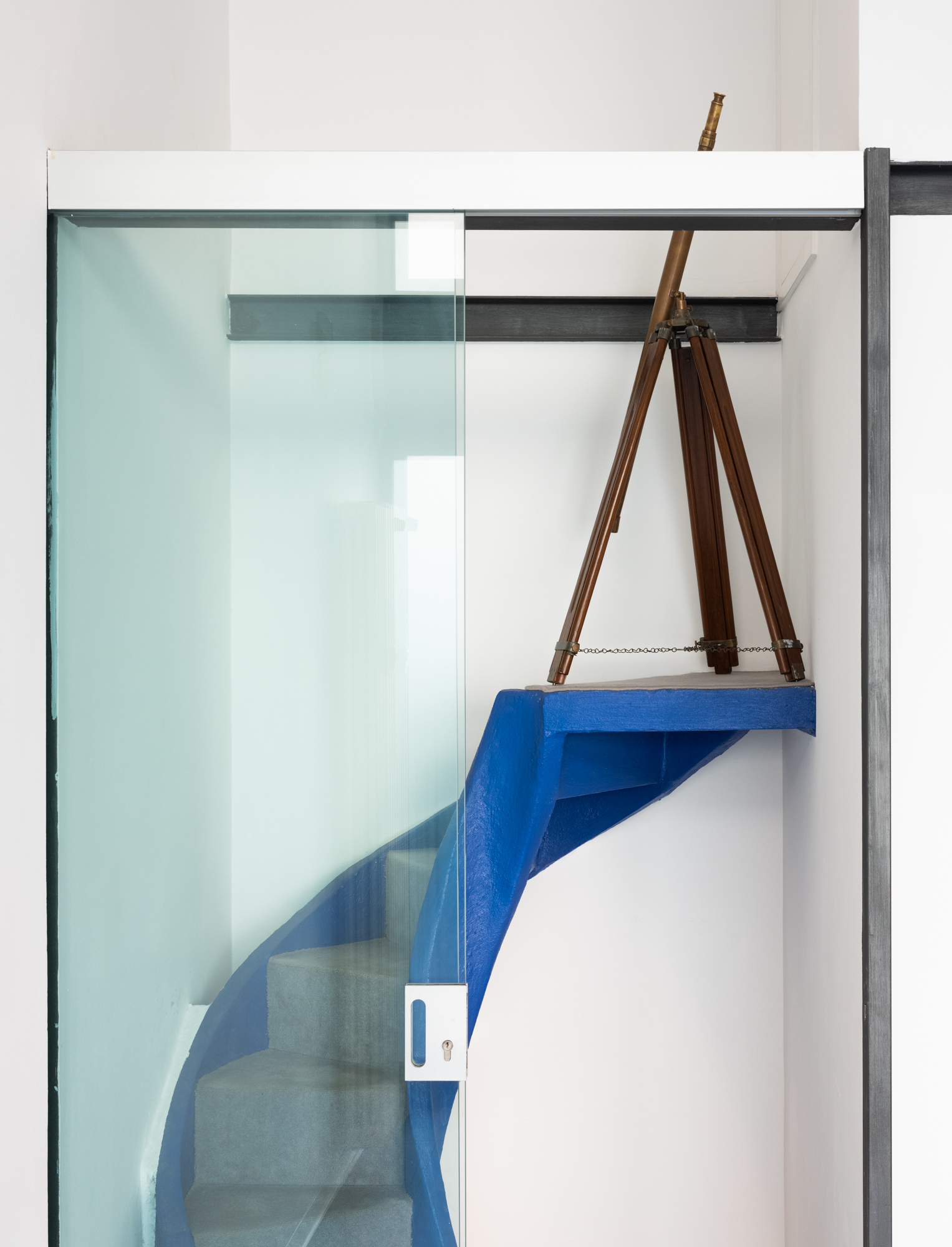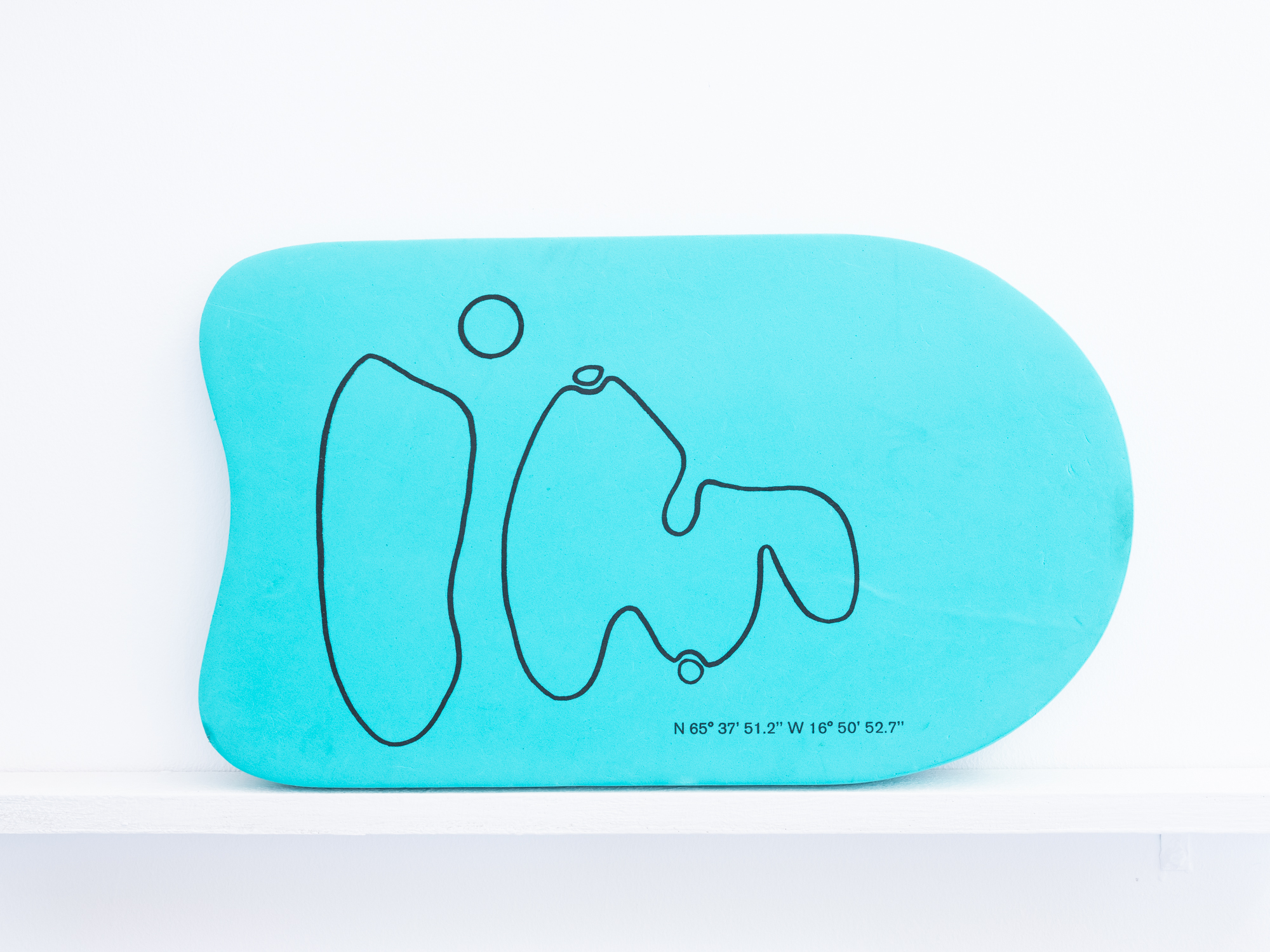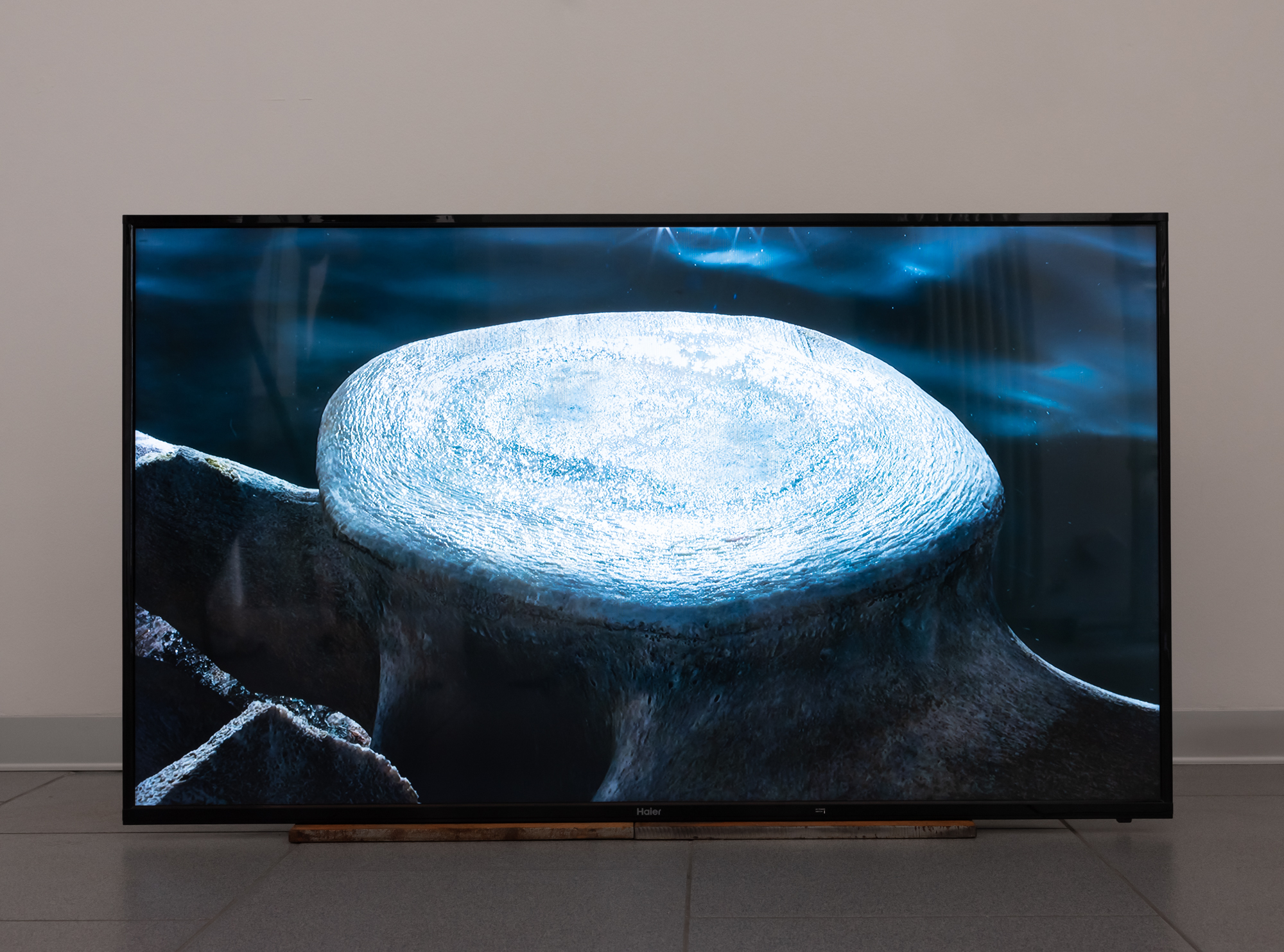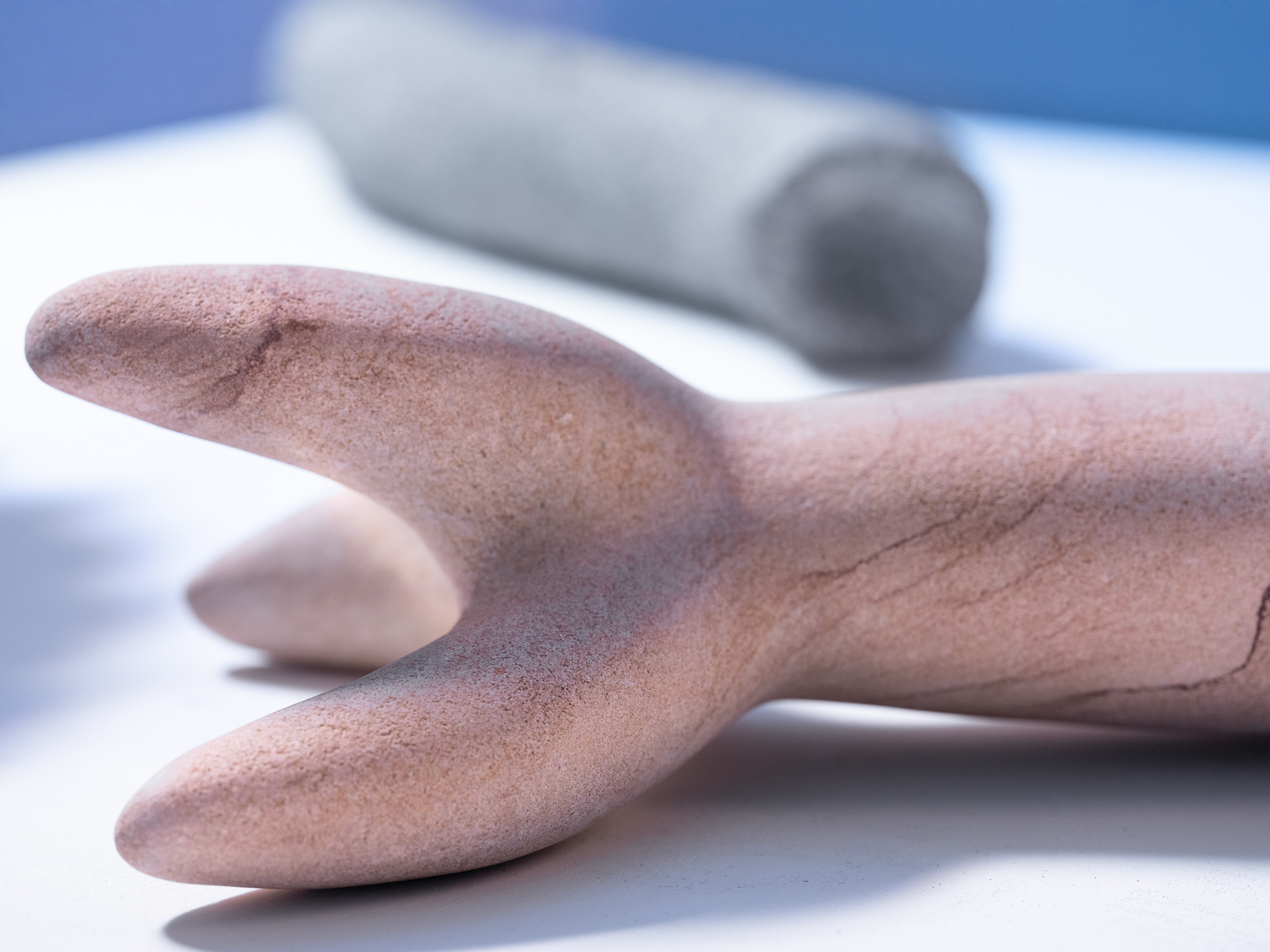Elena Mazzi
Verde intenso con note di blu7 October 2022 ︎︎︎ 12 February 2023
di Michela Lupieri
Elena Mazzi nuota. In un arco temporale compreso tra i suoi primi anni di vita e oggi nuotare è stato disciplina, poi diventato libertà fisica - per quella sensazione di fluttuare in un liquido blu infinito - e, adesso, libertà mentale. “Quando nuoto mi vengono le ispirazioni migliori, sgombro la mente da ogni preoccupazione, scandendo ritualmente bracciate e respiri”.
Elena Mazzi swims. In a time span between her first years of life and today, swimming was a discipline, then it became physical freedom – for that feeling of floating in an infinite blue liquid – and, now, mental freedom. “When I swim I get the best inspirations, I clear my mind of all worries, ritually beating strokes and breaths”.

Nel 2017, tuffandosi da una scogliera, l’artista ha subito un grave incidente alla schiena che l’ha costretta ad un’operazione alla colonna vertebrale. Dall’istante in cui c’è stato l’impatto con l’acqua ricorda di aver avuto il terrore di non poter più vivere quelle sensazioni fisiche e mentali da sempre provate, un trauma difficile da superare che l’ha costretta a stare a riposo per molto tempo. Recentemente, mi ha parlato di un libro che le era stato regalato: Swimming Studiesè la storia di un’ex nuotatrice agonistica ma anche di un’artista. Nel libro, l’autrice alterna ai suoi scritti acquerelli, ritratti, dipinti e foto in sequenza di tutti i costumi usati nelle diverse gare agonistiche che, come dice Mazzi, sono “una sorta di mappatura visiva” capace di restituire la fatica, il rigore, l’esercizio quotidiano e quella percezione che si ha di ogni singola parte del proprio corpo, vivo, in movimento, mentre si nuota. Di fatto è “il racconto personale di come i due mondi, quello dell’arte e dell’attività agonistica, si intreccino costantemente, in una continua rincorsa al raggiungimento della pazienza necessaria per l’una o l’altra cosa, mista a frustrazione, costanza, fiducia, sentimento, sforzo fisico.”
In 2017, diving off a cliff, the artist suffered a serious back injury and underwent a consequent spinal operation. From the moment of the impact with the water, she remembers having been terrified of not being able to live those physical and mental sensations she had always felt, a trauma that was difficult to overcome and that forced her to rest for a long time. Recently, she told me about a book that had been given to her: Swimming Studies is the story of a former competitive swimmer but also of an artist. In the book, the author alternates her writings with watercolours, portraits, paintings and photos in sequence of all the costumes used in the various competitive competitions which, as Mazzi says, are “a sort of visual mapping” capable of restoring fatigue, rigour, daily exercise and the perception you have of every single part of your body, alive, in motion, while swimming. At the same time, the book, thanks to the alternation of images and words, refers to those ethereal sensations of weightlessness, silence and estrangement from a precise context that you feel only when you are underwater. In fact, it is “the personal story of how the two worlds, art and competitive activity, constantly intertwine, in a continuous chase to achieve the patience necessary for one or the other, mixed with frustration, constancy, trust, feeling, physical effort.


Questa mostra è il risultato di un approccio site specific dell’artista che, in
continuità con la sua metodologia di lettura ed esplorazione dei luoghi, ha
indagato la natura dello spazio al fine di coglierne le peculiarità. Queste
superfici vetrate “mi hanno portato ad immaginare
una sorta di spazio composito definito dall'elemento dell’acqua” dice l’artista
e, quindi, una mostra che, data la natura “curativa” del luogo, non ha
potuto prescindere dal vissuto personale dell’artista.
Per questi motivi Mazzi ha deciso di presentare il ciclo di lavori sviluppato in seguito all’incidente subito alla propria colonna vertebrale. Le piscine, quelle riscaldate o termali sono diventate, soprattutto da dopo l’incidente, uno spazio necessario, curativo, per una riabilitazione fisica e mentale, dove potersi dedicare in solitaria all'esercizio fisico del nuoto, per riabituare il corpo al movimento e dove pensare. Lo stesso titolo Verde intenso con note di blu, frammento di una poesia, è un rimando visivo agli elementi naturali e ai colori dei paesaggi dei luoghi - distanti ma geograficamente simili - in cui Elena è stata e in cui ci conduce attraverso questi lavori.
Per questi motivi Mazzi ha deciso di presentare il ciclo di lavori sviluppato in seguito all’incidente subito alla propria colonna vertebrale. Le piscine, quelle riscaldate o termali sono diventate, soprattutto da dopo l’incidente, uno spazio necessario, curativo, per una riabilitazione fisica e mentale, dove potersi dedicare in solitaria all'esercizio fisico del nuoto, per riabituare il corpo al movimento e dove pensare. Lo stesso titolo Verde intenso con note di blu, frammento di una poesia, è un rimando visivo agli elementi naturali e ai colori dei paesaggi dei luoghi - distanti ma geograficamente simili - in cui Elena è stata e in cui ci conduce attraverso questi lavori.
This exhibition is the result of a site-specific
approach by the artist who, in continuity with her method of reading and
exploring places, investigated the nature of these rooms in order to grasp its
distinctive traits. These glass surfaces “led me to imagine a sort of composite
space defined by the element of water” says the artist and, therefore, an exhibition
that, given the “curative” nature of the place, could not ignore the artist’s
personal experience.
For these reasons, Mazzi has decided to present the cycle of work developed following the accident which affected her spine. The swimming pools, heated or thermal ones, have become, especially after the accident, a necessary, curative space for physical and mental rehabilitation, where she can dedicate herself to the physical exercise of swimming, to get the body used to movement again and to think. The same title Verde intenso con note di blu, a fragment of a poem, is a visual reference to the natural elements and the colours of the landscapes of the – distant but geographically similar – places where Elena has been and where she leads us through these works.
For these reasons, Mazzi has decided to present the cycle of work developed following the accident which affected her spine. The swimming pools, heated or thermal ones, have become, especially after the accident, a necessary, curative space for physical and mental rehabilitation, where she can dedicate herself to the physical exercise of swimming, to get the body used to movement again and to think. The same title Verde intenso con note di blu, a fragment of a poem, is a visual reference to the natural elements and the colours of the landscapes of the – distant but geographically similar – places where Elena has been and where she leads us through these works.

“Orizzonte mobile” racchiude
la stratificata complessità della ricerca dell’artista: da una parte il suo
spingere lo sguardo verso orizzonti lontani, luoghi in cui si reca per
sviluppare progetti a lungo termine, in dialogo con le comunità e con le loro
tradizioni, culture, storie; ma anche con i paesaggi che osserva. Dall’altra,
la sua mobilità fisico intellettiva che si traduce in un’azione dinamica e di
ricerca nello spazio, intrecciata a studi e letture disparate. Per questo Mazzi
si avvicina alla figura del walker di
cui scrive l’antropologo Tim Ingold, una camminatrice il cui sapere si evolve
in relazione ai luoghi che attraversa.
Nel walkerinfatti, la conoscenza si struttura e arricchisce passo dopo passo.
L’indagine di territori specifici - da L’Aquila alla Svezia, passando per Venezia, la Sicilia e l’Abruzzo, dal Messico, Argentina e Lapponia, fino ai luoghi di questa mostra, l’Islanda e la Liguria - trasforma le ricerche dell’artista in oggetti/organismi complessi in cui il patrimonio culturale e naturale del luogo indagato si intreccia a dati scientifici e fatti reali, mescolati alle narrazioni trasmesse dalle comunità locali. Ciò che muove l’artista, infatti, è l’urgenza di offrire ad un pubblico più vasto possibile nuovi punti di vista sulla realtà osservata, suggerire nuove chiavi di lettura, possibili risoluzioni ai molteplici conflitti tra uomo e natura, alle situazioni di crisi - collettive e personali -, alle fratture. In questo modo paradigmi esistenti vengono soverchiati, a favore di nuovi orizzonti immaginativi possibili.
Nel walkerinfatti, la conoscenza si struttura e arricchisce passo dopo passo.
L’indagine di territori specifici - da L’Aquila alla Svezia, passando per Venezia, la Sicilia e l’Abruzzo, dal Messico, Argentina e Lapponia, fino ai luoghi di questa mostra, l’Islanda e la Liguria - trasforma le ricerche dell’artista in oggetti/organismi complessi in cui il patrimonio culturale e naturale del luogo indagato si intreccia a dati scientifici e fatti reali, mescolati alle narrazioni trasmesse dalle comunità locali. Ciò che muove l’artista, infatti, è l’urgenza di offrire ad un pubblico più vasto possibile nuovi punti di vista sulla realtà osservata, suggerire nuove chiavi di lettura, possibili risoluzioni ai molteplici conflitti tra uomo e natura, alle situazioni di crisi - collettive e personali -, alle fratture. In questo modo paradigmi esistenti vengono soverchiati, a favore di nuovi orizzonti immaginativi possibili.
“Mobile horizon” contains the layered complexity of the
artist’s research. On the one hand, there is her gaze towards distant horizons,
places where she goes to develop long-term projects, in dialogue with
communities and their traditions, cultures, stories; but also with the
landscapes she observes.
On the other hand, her physical and intellectual mobility is translated into a dynamic action and research in space, intertwined with disparate studies and readings.
This is why Mazzi approaches the figure of the walker of which the anthropologist Tim Ingold writes, a walker whose knowledge evolves in relation to the places she passes through.
The investigation of specific territories – from L’Aquila to Sweden, passing through Venice, Sicily and Abruzzo, from Mexico, Argentina and Lapland, to the places of this exhibition, Iceland and Liguria – transforms the research of the artist in complex objects/organisms in which the cultural and natural heritage of the investigated place is intertwined with scientific data and real facts, mixed with the narratives transmitted by local communities. What moves the artist is the urgency to offer to the widest possible audience new points of view on the observed reality, to suggest new interpretations, possible resolutions to the multiple conflicts between human and nature, to – collective and personal – crisis situations, to fractures.
In this way existing paradigms are overwhelmed, in favour of new possible imaginative horizons.
On the other hand, her physical and intellectual mobility is translated into a dynamic action and research in space, intertwined with disparate studies and readings.
This is why Mazzi approaches the figure of the walker of which the anthropologist Tim Ingold writes, a walker whose knowledge evolves in relation to the places she passes through.
The investigation of specific territories – from L’Aquila to Sweden, passing through Venice, Sicily and Abruzzo, from Mexico, Argentina and Lapland, to the places of this exhibition, Iceland and Liguria – transforms the research of the artist in complex objects/organisms in which the cultural and natural heritage of the investigated place is intertwined with scientific data and real facts, mixed with the narratives transmitted by local communities. What moves the artist is the urgency to offer to the widest possible audience new points of view on the observed reality, to suggest new interpretations, possible resolutions to the multiple conflicts between human and nature, to – collective and personal – crisis situations, to fractures.
In this way existing paradigms are overwhelmed, in favour of new possible imaginative horizons.







La metodologia di ricerca applicata, vicina
all’antropologia, privilegia un approccio olistico, a parer mio fluido, dove il
suo sguardo artistico si ibrida nel confronto diretto con altro. In questo
ampio orizzonte mobile di ricerca, i suoi progetti, e nello specifico quelli
esposti in questa mostra, restituiscono le indagini complesse sui rapporti e
sulle relazioni tra essere umano e animale, in specifici ambienti naturali di
carattere acquatico. Per questo, a partire da una storia personale e da un
trauma individuale, Mazzi è riuscita ad allontanarlo da sé, ampliare la
riflessione, trasformare uno specifico evento in uno strumento di lettura per
situazioni altre e generali. Ciò che unisce i diversi lavori di questa mostra,
inserendoli in un orizzonte teorico allargato, è il loro rimando e riferimento
a diverse teorie di Donna Haraway. Nei suoi scritti Haraway insegna a stare con
il problema, a viverci, a conviverci, a provare ad affrontarlo collettivamente,
interrogando e dialogando con altre specie. “Nei miei lavori, come in Encounters e Spicule, provo a mettere in pratica il suo pensiero”.
The applied research methodology, close to
anthropology, favours a holistic approach, in my opinion fluid, where her
artistic gaze is hybridised in direct confrontation with someone or something
else. In this broad mobile horizon of research, her projects, and specifically
those presented in this exhibition, return the complex investigations on the
relationships and bonds between human beings and animals, in specific natural
aquatic environments. For this reason, starting from a personal story and an
individual trauma, Mazzi managed to detach from herself, broaden the
reflection, transform a specific event into a reading tool for other and
general situations. What unites the works of this exhibition and inserts them
in an enlarged theoretical horizon, is their reference and link to different
theories of Donna Haraway. In her writings, Haraway teaches us to stay with the
problem, to live with it, to try to deal with it collectively, by questioning
and dialoguing with other species. In my works, as in Encounters and Spicule, I
try to put her thinking into practice”.




